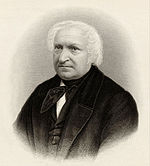Doctor Faust. A dance poem
Doctor Faust. A dance poem is one of Heinrich Heine's last works , published by his publisher Julius Campe . Heine wrote it around 1846 at the request of the director of Her Majesty's Theater in London. He was planning a ballet for the current season , but this became superfluous due to successful performances by the singer Jenny Lind , the "Swedish nightingale" called.
History of origin
Even at a young age, Heine was fascinated by Goethe's “ Faust ”. During his trip to the Harz Mountains in 1824, the two met, whereby Goethe, to Heine's disappointment, seemed very distant. In the years that followed he dealt with Faust several times, but stopped working in 1826.
It was only during the time of the mattress tomb, which lasted until the end of his life, that Heine thought about the fist material.
Opera director Benjamin Lumley (1811–1875), informed by Théophile Gautier about Heine's literary contribution to the then successful ballet “ Giselle ”, visited Heine in his Paris apartment in 1846/47. Even back then, Lumley dreamed of processing the fist material - an "idée original". From late November 1846 to early February 1847, Heine wrote down Doctor Faust . After it was handed over on December 28, Heine sent his explanations for a program booklet on February 27.
However, due to internal quarrels between the choreographers and the continued success of Jenny Lind, the piece was canceled; Nevertheless, Heine received a high severance payment of £ 240. The work was now to be published in 1851 as the fourth book in the Romanzero collection of poems . But since the publisher Julius Campe doubted the mass effectiveness of this book and did not want to destroy the entire work with it, the first 5000 copies appeared under the title “Der Doktor Faust. A dance poem, along with curious reports about devils, witches and poetry ” . The first edition was 106 pages.
content
1st act: midnight
Faust conjures the devil: thunder and lightning, the earth opens, Mephistophela appears. Faust, skeptical and hesitant at first, later interested and increasingly fascinated, lets the devil teach her to dance, which ultimately succeeds after unsuccessful attempts. The appearance of a mirage seduces him to the devil's pact: earthly pleasures at the price of his heavenly bliss. A diabolical ballet (with the princes of Hell) celebrates the signing.
2nd act: Fürstenhof with Duke and Duchess
Faust recognizes the illusion in the figure of the Duchess. During Faust's intimate dance with the Duchess, her husband is distracted by Mephistophela with a dance. A devil's mark on her neck reveals the Duchess as a sorceress, whereupon Faust invites her to the next Witches Sabbath. The Duke notices the flirtation, the situation escalates, Faust and Mephistophela flee.
3rd act: Witches' Sabbath (meeting of the underworld)
Masked hell beings worship a black goat statue and perform dances. Faust and the Duchess dance again and disappear for a short time in the bushes. When she then surrenders to the black goat, Faust is disgusted. He and Mephistophela decide to flee. At the first ray of sun the black goat goes up in flames - the spook is over.
4th act: An island in the archipelago
Faust and Mephistophela reach the temple of Aphrodite, where Helen of Troy is staying. Faust sees in her the pure naturalness and beauty, both of them fall into ecstasy when dancing for two. The Duchess followed; enraged at the sight of the dancers, she turns everything into ugly and swears by storms. Faust, disturbed in his madness and furious, stabs her. He and Mephistophela flee the floods and the island sinks.
5th act: Riflemen's parade in front of a cathedral
In the midst of the hustle and bustle, Faust falls in love with the mayor's daughter, holds for her hand, whereupon Mephistophela disturbs the bridal procession that is forming in a flash, conjures up a terrible thunderstorm and reminds Faust of his contractual obligations - his earthly pleasures are over. The people flee to the nearby cathedral, Faust - after trying in vain to avert the disaster - asks for mercy. Mephistophela, transformed into a snake, strangles Faust. The earth opens, the diabolical court disappears with his fist into hell.
literature
- Heinrich Heine: Doctor Faust. A dance poem. Along with curious reports about devils, witches and poetry . With drawings by József Divéky . Morawe & Scheffelt Verlag, Berlin 1912. With a loosely enclosed afterword by Karl Georg Wendriner. Bibliophile print in 400 numbered copies. A reprint in a reduced format, without the afterword and in a new sentence:
- Heinrich Heine: Doctor Faust. A dance poem. Along with curious reports about devils, witches and poetry . With drawings by József Divéky. Insel Verlag, Frankfurt am Main 1987 - Insel-Bücherei 1030/2 ( ISBN 3-458-19030-9 )
- Heinrich Heine: Doctor Faust. A dance poem . Bibliographically amended edition. Reclam, Stuttgart 2007, ISBN 978-3-15-003605-1 .
- Max Niehaus: Heaven, Hell and Trikot. Heinrich Heine and the ballet . Nymphenburger Verlagshandlung, Munich 1959.
- Roland Lillie: The Faust on the dance stage. The fist theme in pantomime and ballet . Phil. Dissertation, Berlin 1967 (also: Schön, Munich 1968).
Settings
- Werner Egk Abraxas - a Faust ballet after Heinrich Heine (1948)
- Bertold Hummel Faustszenen - Ballet based on a dance poem by Heinrich Heine op.72 (1979)
Web links
- Heine's dance poem; Ballets and pantomimes www.johannfaust.de
- Digitized version of the 1851 edition on Google Book Search
- Full text at Zeno.org
- Timeline ( memento of December 9, 2008 in the Internet Archive ) on the literary processing of the subject matter
- Heinrich Heine: Doctor Faust in the Gutenberg-DE project
- Description of the contents of a setting by Bertold Hummel

